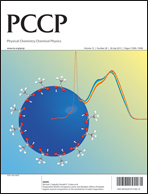Normal solvatochromic phenomena are induced by different polarities of the ground and excited states of a compound when it is dissolved in a solvent. A compound such as the perylene diimide (PDI) derivative, which has a small difference in the dipole moments of the excited and ground states, generally shows a weak color change. Herein, we found that a dilute dichloromethane (DCM) solution of the PDI derivative 1,6,7,12-tetra(4-tert-butylphenoxyl) PDI (1) with a typical concentration of 1 × 10−5 M distinctly changed colour from red to dark blue with a distinct red-shift of both the absorption (Δλamax = 32 nm) and the fluorescence (Δλfmax = 45 nm) when 50 000 equivalents of trifluoroacetic acid (TFA) were added. Such a new chromism originates from the stronger decrease of the energy level of the LUMO than that of the HOMO after the step-by-step H-bonding of TFA with the PDI chromophore: firstly, the imide C![[double bond, length as m-dash]](https://www.rsc.org/images/entities/char_e001.gif) O functionality, then the bridged –O– and finally the TFA molecules undergo H-bonding, forming a highly polar TFA shell around the PDI molecule, as proved by the concentration variable UV-vis absorption, fluorescence, 1H NMR, 13C NMR, and NOE spectra, cyclic voltammetry, and quantum chemical calculations. The degree of the solution’s color change (Δλamax/Δλfmax) depends (1) on the number of the bay-substituted 4-n-butylphenoxyl groups: it amounts to 25/38 and 17/22 nm for 1,7-bis(4-tert-butylphenoxyl) PDI (2) and the bay-unsubstituted PDI 3, respectively, and (2) on the polarity of the –OH functionality: in HOOC–CX3, for example, the value of Δλamax/Δλfmax of PDI 1 amounts to 9.5/17 nm for trichloroacetic acid (TClA, X = Cl) and 0/3.6 nm for acetic acid (AA, X = H). The protons are necessary for the chromism, and thus ethyl trifluoroacetic acid ester, EtOTFA, cannot produce any obvious red-shifting of the absorption and fluorescence for 1–3. However, 2,2,2-trifluoroethanol (TFEtOH) produces an obvious red-shift.
O functionality, then the bridged –O– and finally the TFA molecules undergo H-bonding, forming a highly polar TFA shell around the PDI molecule, as proved by the concentration variable UV-vis absorption, fluorescence, 1H NMR, 13C NMR, and NOE spectra, cyclic voltammetry, and quantum chemical calculations. The degree of the solution’s color change (Δλamax/Δλfmax) depends (1) on the number of the bay-substituted 4-n-butylphenoxyl groups: it amounts to 25/38 and 17/22 nm for 1,7-bis(4-tert-butylphenoxyl) PDI (2) and the bay-unsubstituted PDI 3, respectively, and (2) on the polarity of the –OH functionality: in HOOC–CX3, for example, the value of Δλamax/Δλfmax of PDI 1 amounts to 9.5/17 nm for trichloroacetic acid (TClA, X = Cl) and 0/3.6 nm for acetic acid (AA, X = H). The protons are necessary for the chromism, and thus ethyl trifluoroacetic acid ester, EtOTFA, cannot produce any obvious red-shifting of the absorption and fluorescence for 1–3. However, 2,2,2-trifluoroethanol (TFEtOH) produces an obvious red-shift.
![[double bond, length as m-dash]](https://www.rsc.org/images/entities/char_e001.gif) O functionality, then the bridged –O– and finally the TFA molecules undergo H-bonding, forming a highly polar TFA shell around the PDI molecule, as proved by the concentration variable UV-vis absorption, fluorescence,
O functionality, then the bridged –O– and finally the TFA molecules undergo H-bonding, forming a highly polar TFA shell around the PDI molecule, as proved by the concentration variable UV-vis absorption, fluorescence, 

 Please wait while we load your content...
Please wait while we load your content...